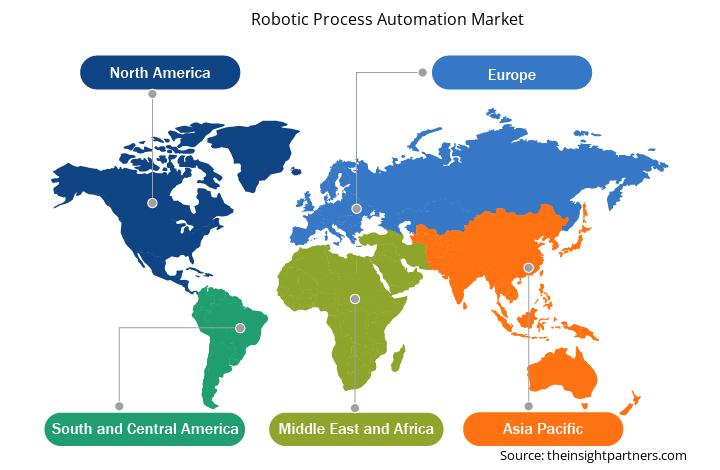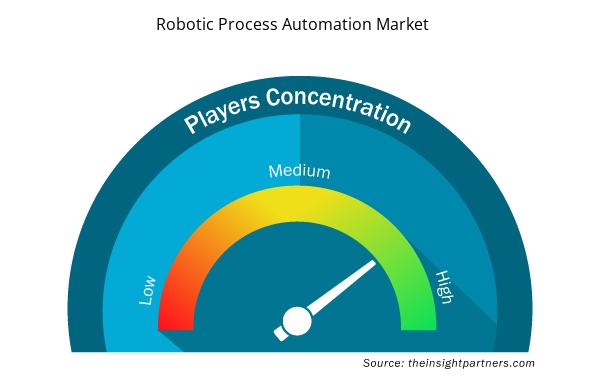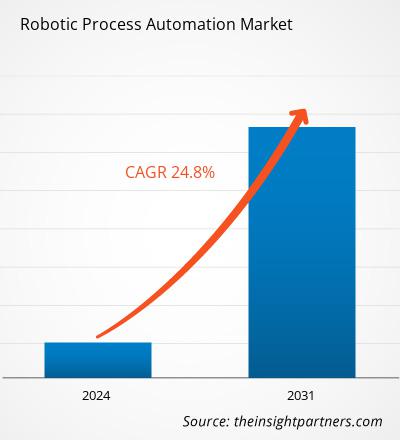ロボティック・プロセス・オートメーション(RPA)市場規模は、2024年の44億8,000万米ドルから2031年には208億3,000万米ドルに達すると予測されています。市場は2025年から 2031年にかけて年平均成長率(CAGR) 24.8%を記録すると予測されています。技術の進歩は今後数年間で市場に新たなトレンドをもたらす可能性が高いでしょう。
ロボティック・プロセス・オートメーション市場分析
世界のロボティック・プロセス・オートメーション(RPA)市場は大幅な成長を遂げており、今後数年間も拡大を続けると予測されています。企業プロセスの自動化に対する需要の高まりは、RPA技術の導入を促進する主要な要因の一つです。さらに、BPOおよびBFSIセクターにおけるRPA導入の増加も、市場の成長を後押ししています。また、企業は人工知能(AI)などの技術を統合した高度な機能を備えたRPAソリューションを選択しています。RPA市場における企業間の連携は、強化されたRPAソリューションの開発につながっています。例えば、2023年6月には、GoogleとAutomation Anywhereの提携により、より優れたRPAソリューションが市場で利用可能になりました。
ロボティック・プロセス・オートメーション(RPA)ソリューションがビジネスオペレーションの効率性と生産性を向上させる能力は、RPA市場を牽引しています。さらに、コグニティブRPAの需要の高まりと小売業界におけるRPA導入の増加は、今後数年間の市場成長の機会を生み出すと予想されます。さらに、RPAにおける技術の進歩も、予測期間中の市場成長を牽引すると予想されます。
ロボティック・プロセス・オートメーション市場の概要
ロボティック・プロセス・オートメーション(RPA)は、デジタルシステムやソフトウェアとのインタラクションにおける人間の行動をシミュレートすることで、反復的なタスクやプロセスの自動化を支援するソフトウェア技術の一種です。ロボットは、画面の理解、キー入力の補完、システムナビゲーション、データの抽出など、さまざまな定義済みアクションを実行できます。これらのソフトウェアロボットは、休憩を必要とせず、人間と比較してタスク実行速度と一貫性が向上します。ロボット主導の自動化は、産業革命における機械の変革と同じくらい、現代の職場を大きく変革する可能性を秘めています。インテリジェントオートメーション(IA)とRPAはそれぞれ異なるアプローチを採用していますが、ビジネスプロセスをより効率的かつインテリジェントにすることで強化します。どちらの手法も、従来のIT実装に比べて大きなメリットをもたらします。
要件に合わせてレポートをカスタマイズ
このレポートの一部、国レベルの分析、Excelデータパックなど、あらゆるレポートを無料でカスタマイズできます。また、スタートアップや大学向けのお得なオファーや割引もご利用いただけます。
ロボティック・プロセス・オートメーション市場:

- このレポートの主要な市場動向を入手してください。この無料サンプルには、市場動向から見積もりや予測に至るまでのデータ分析が含まれます。
ロボティック・プロセス・オートメーション市場の推進要因と機会
ロボティック・プロセス・オートメーションによるコストメリット
ロボティック・プロセス・オートメーション(RPA)は、ユーザーがRPA管理サービスを自社内外に委託できる機能を提供し、余分なコストをかけずにプロセスのガバナンスを取り戻すことを可能にします。発生するコストは、 RPAを使用しないオフショアプロセスよりも低くなる可能性があります。
業務オペレーションにおけるロボティック・プロセス・オートメーション(RPA)の導入拡大は、企業全体のコスト管理の改善とコスト予測の精度向上に役立ち、ひいては従業員やスタッフをより戦略的に価値の高い役割に配置できる機会を見出すことを可能にします。さらに、RPAを業務の主流に段階的に移行させることで、多くの組織が従来のサービスプロバイダーから最新のRPA機能へとスムーズに移行できるようになります。RPAを活用した取引への投資を促すもう一つの重要な要因は、収益性維持へのプレッシャーの高まり、増加するオフショアリングコストの適切な管理、そして規制問題です。このように、RPAを業務オペレーションに導入することによるコストメリットが、市場の成長を牽引しています。
認知型ロボティック・プロセス・オートメーションの需要の高まり
コグニティブ・コンピューティング、機械学習(ML)、人工知能(AI)といった新技術の発展は、ロボティック・プロセス・オートメーション(RPA)ツールの進化を加速させると予想されます。インテリジェント技術の応用により、人員配置や経費管理から業務遂行や生産性向上に至るまで、あらゆるビジネスプロセスを統合できる、より優れたフレームワークの開発につながる施策が生み出されると予測されます。
さまざまなエンドユーザーが、生産性を向上させて業務を強化するために、AIおよびMLベースのRPAを導入するケースが増えています。MLとAI機能を備えたRPAは、データ分析と理解において新たなトレンドを生み出しています。さらに、AIとMLを活用したロボティック・プロセス・オートメーションの進歩は、企業がより高いRoIと生産性の向上を実現するのに役立っています。これにより、市場プレーヤーは技術機能の進化にますます重点を置くようになっています。たとえば、2023年8月には、eコマース、金融テクノロジー、デジタルマーケティング向けのニッチなAIおよびMLソリューションのリーディングプレーヤーであるZuci Systemsが、ロボティック・プロセス・オートメーション業界の大手プレーヤーであるUiPathとの提携を発表しました。この提携により、両社は複数の業界の何千もの企業が自動化を通じてビジネスプロセスを改善できるよう支援することができます。この提携により、Zuciの顧客はUiPathボットにアクセスして、大規模な非構造化データセットを管理し、運用コストを削減し、市場投入までの時間を短縮することができます。さらに、この提携により、主要なビジネスプロセスのエンドツーエンドの自動化が実現し、顧客満足度の向上、リスクの軽減、そしてより迅速、正確、安全、そして大規模な取引の実行が可能になります。さらに、コグニティブRPAの進化は、市場規模の拡大だけでなく、新たな専門知識に対する需要の高まりも引き起こすでしょう。これは、特にコンサルティングやトレーニングサービスにおいて、RPAサービスプロバイダーにとって新たなビジネスチャンスを生み出すでしょう。さらに、金融サービスや製造業といった業界は、コグニティブRPAから最も大きな恩恵を受けると予想されています。このように、コグニティブRPAの需要の高まりは、RPA市場の成長機会を生み出すと期待されます。
ロボティック・プロセス・オートメーション市場レポートのセグメンテーション分析
ロボティック プロセス オートメーション市場分析の導出に貢献した主なセグメントは、コンポーネント、展開、組織規模、およびエンドユーザー業界です。
- 市場はコンポーネントに基づいてソリューションとサービスに分類されます。2024年にはソリューションセグメントが市場を支配しました。
- 導入の観点から見ると、市場はオンプレミスとクラウドに分かれており、2024年にはオンプレミスセグメントが市場を支配しました。
- 組織規模に基づいて、市場は中小企業と大企業に分類されます。2024年には大企業セグメントが市場を支配しました。
- 最終用途産業に基づいて、市場はBFSI、eコマース・小売、ヘルスケア、IT・通信、製造業、その他に分類されています。2024年にはBFSIセグメントが市場を支配しました。
ロボティック・プロセス・オートメーション(RPA)の地域別市場シェア分析
ロボティック プロセス オートメーション市場は、北米、ヨーロッパ、アジア太平洋 (APAC)、中東およびアフリカ (MEA)、南米および中米の 5 つの主要地域に分割されています。
ロボティック・プロセス・オートメーション(RPA)市場は北米が最大規模で、次いでヨーロッパとアジア太平洋が続いています。北米のRPA市場は、米国、カナダ、メキシコに区分されています。米国とカナダでは効率的なインフラが整備されているため、製造企業はこの地域で事業を拡大することができました。米国は近代的な技術、高い生活水準、そして十分に発達したインフラを誇ります。技術革新によって、この地域では市場競争が激化しています。グローバル化によって、先進国と発展途上国のほとんどの分野でビジネス競争力がさらに高まっています。企業は顧客体験管理を重視し、初回ユーザーをリピーターに変え、既存顧客を維持するよう努めています。高品質な製品とサービスを求める顧客の需要が高まるにつれ、企業はRPAソリューションの導入を拡大しています。RPAソリューションを活用することで、企業は顧客の要求を満たしながら、プロセス全体を強化することができます。
ロボティック・プロセス・オートメーション市場の地域別分析
Insight Partnersのアナリストは、予測期間を通じてロボティック・プロセス・オートメーション(RPA)市場に影響を与える地域的なトレンドと要因を詳細に解説しています。このセクションでは、北米、ヨーロッパ、アジア太平洋、中東・アフリカ、中南米におけるRPA市場のセグメントと地域についても解説します。

- ロボティック・プロセス・オートメーション市場の地域別データを入手
ロボティック・プロセス・オートメーション市場レポートの範囲
| レポート属性 | 詳細 |
|---|---|
| 2024年の市場規模 | 44億8000万米ドル |
| 2031年までの市場規模 | 208億3000万米ドル |
| 世界のCAGR(2025年~2031年) | 24.8% |
| 履歴データ | 2021-2023 |
| 予測期間 | 2025~2031年 |
| 対象セグメント | コンポーネント別
|
| 対象地域と国 | 北米
|
| 市場リーダーと主要企業の概要 |
|
ロボティック・プロセス・オートメーション市場のプレーヤー密度:ビジネスダイナミクスへの影響を理解する
ロボティック・プロセス・オートメーション(RPA)市場は、消費者の嗜好の変化、技術の進歩、製品メリットへの認知度の向上といった要因によるエンドユーザー需要の高まりに牽引され、急速に成長しています。需要が高まるにつれ、企業は製品ラインナップの拡充、消費者ニーズへの対応のためのイノベーション、そして新たなトレンドの活用を進めており、これが市場の成長をさらに加速させています。
市場プレーヤー密度とは、特定の市場または業界内で事業を展開する企業または会社の分布を指します。これは、特定の市場空間における競合企業(市場プレーヤー)の数が、その市場規模または市場価値全体と比較してどれだけ多いかを示します。
ロボティック・プロセス・オートメーション市場で事業を展開している主要企業は次のとおりです。
- アピアン社
- オートメーション・エニウェア株式会社
- ブループリズム株式会社
- サイクロンロボティクス
- データマティクス・グローバル・サービス・リミテッド
- インターナショナル・ビジネス・マシーンズ・コーポレーション
免責事項:上記の企業は、特定の順序でランク付けされているわけではありません。

- ロボティック・プロセス・オートメーション市場のトップキープレーヤーの概要を入手
ロボティック・プロセス・オートメーション市場のニュースと最近の動向
ロボティック・プロセス・オートメーション(RPA)市場は、主要な企業出版物、協会データ、データベースなどを含む一次調査および二次調査を経て、定性・定量データを収集することで評価されます。RPA市場における動向のいくつかを以下に示します。
- Automation Anywhere Inc.は、PwC Indiaとの戦略的提携を発表しました。この提携は、クライアントの組織全体の成長、生産性、コスト効率の向上を支援することを目的としています。この提携により、Automation Anywhereの最先端技術の専門知識と、PwC Indiaの深い業界洞察力およびコンサルティング経験が融合されます。(出典:Automation Anywhere Inc.、プレスリリース、2024年11月)
- SAPは、2024年ガートナー社のRPAマジック・クアドラントにおいて、「実行能力」と「ビジョンの完全性」の両面で高く評価されました。この評価は、SAPの強力な製品ラインナップ、顧客向けプログラムへの継続的な投資、そしてSAP S/4HANA、SAP Signavio、SAP BTP間の緊密な統合を実証するものです。(出典:TE Connectivity、プレスリリース、2024年9月)
ロボティック・プロセス・オートメーション市場レポートの対象範囲と成果物
「ロボティック・プロセス・オートメーション市場規模と予測(2021~2031年)」では、以下の分野を網羅した市場の詳細な分析を提供しています。
- 対象範囲に含まれるすべての主要市場セグメントにおける、世界、地域、国レベルでのロボットプロセスオートメーション市場の規模と予測
- ロボティックプロセスオートメーション市場の動向、および推進要因、制約、主要な機会などの市場動向
- 詳細なPEST分析とSWOT分析
- 主要な市場動向、世界および地域の枠組み、主要プレーヤー、規制、最近の市場動向を網羅したロボティックプロセスオートメーション市場分析
- 市場集中、ヒートマップ分析、主要プレーヤー、ロボティックプロセスオートメーション市場の最近の動向を網羅した業界の展望と競争分析
- 詳細な企業プロフィール
- 過去2年間の分析、基準年、CAGRによる予測(7年間)
- PEST分析とSWOT分析
- 市場規模価値/数量 - 世界、地域、国
- 業界と競争環境
- Excel データセット



Report Coverage
Revenue forecast, Company Analysis, Industry landscape, Growth factors, and Trends

Segment Covered
This text is related
to segments covered.

Regional Scope
North America, Europe, Asia Pacific, Middle East & Africa, South & Central America

Country Scope
This text is related
to country scope.
よくある質問
Technological advancements to play a significant role in the global robotic process automation market in the coming years.
The global robotic process automation market is expected to reach US$ 20.83 billion by 2031.
The global Robotic process automation market is estimated to register a CAGR of 24.8% during the forecast period 2024–2031.
The key players holding majority shares in the global robotic process automation market are Appian Corp; Automation Anywhere, Inc.; Blue Prism Ltd; Cyclone Robotics; Datamatics Global Services Limited; International Business Machines Corp; Microsoft Corp; NICE Ltd.; Pegasystems Inc; Salesforce Inc; SAP SE; and UiPath Inc.
North America dominated the robotic process automation market in 2024.
Increased demand for robotic process automation in BPO; cost benefits offered by robotic process automation; and rise in use of robotic process automation in BFSI sector are the major factors that propel the global robotic process automation market.
Trends and growth analysis reports related to Technology, Media and Telecommunications : READ MORE..
The List of Companies - Robotic Process Automation Market
- Appian Corp
- Automation Anywhere, Inc.
- Blue Prism Ltd
- Cyclone Robotics
- Datamatics Global Services Limited
- International Business Machines Corp
- Microsoft Corp
- NICE Ltd.
- Pegasystems Inc
- Salesforce Inc
- SAP SE
- UiPath Inc
The Insight Partners performs research in 4 major stages: Data Collection & Secondary Research, Primary Research, Data Analysis and Data Triangulation & Final Review.
- Data Collection and Secondary Research:
As a market research and consulting firm operating from a decade, we have published and advised several client across the globe. First step for any study will start with an assessment of currently available data and insights from existing reports. Further, historical and current market information is collected from Investor Presentations, Annual Reports, SEC Filings, etc., and other information related to company’s performance and market positioning are gathered from Paid Databases (Factiva, Hoovers, and Reuters) and various other publications available in public domain.
Several associations trade associates, technical forums, institutes, societies and organization are accessed to gain technical as well as market related insights through their publications such as research papers, blogs and press releases related to the studies are referred to get cues about the market. Further, white papers, journals, magazines, and other news articles published in last 3 years are scrutinized and analyzed to understand the current market trends.
- Primary Research:
The primarily interview analysis comprise of data obtained from industry participants interview and answers to survey questions gathered by in-house primary team.
For primary research, interviews are conducted with industry experts/CEOs/Marketing Managers/VPs/Subject Matter Experts from both demand and supply side to get a 360-degree view of the market. The primary team conducts several interviews based on the complexity of the markets to understand the various market trends and dynamics which makes research more credible and precise.
A typical research interview fulfils the following functions:
- Provides first-hand information on the market size, market trends, growth trends, competitive landscape, and outlook
- Validates and strengthens in-house secondary research findings
- Develops the analysis team’s expertise and market understanding
Primary research involves email interactions and telephone interviews for each market, category, segment, and sub-segment across geographies. The participants who typically take part in such a process include, but are not limited to:
- Industry participants: VPs, business development managers, market intelligence managers and national sales managers
- Outside experts: Valuation experts, research analysts and key opinion leaders specializing in the electronics and semiconductor industry.
Below is the breakup of our primary respondents by company, designation, and region:

Once we receive the confirmation from primary research sources or primary respondents, we finalize the base year market estimation and forecast the data as per the macroeconomic and microeconomic factors assessed during data collection.
- Data Analysis:
Once data is validated through both secondary as well as primary respondents, we finalize the market estimations by hypothesis formulation and factor analysis at regional and country level.
- Macro-Economic Factor Analysis:
We analyse macroeconomic indicators such the gross domestic product (GDP), increase in the demand for goods and services across industries, technological advancement, regional economic growth, governmental policies, the influence of COVID-19, PEST analysis, and other aspects. This analysis aids in setting benchmarks for various nations/regions and approximating market splits. Additionally, the general trend of the aforementioned components aid in determining the market's development possibilities.
- Country Level Data:
Various factors that are especially aligned to the country are taken into account to determine the market size for a certain area and country, including the presence of vendors, such as headquarters and offices, the country's GDP, demand patterns, and industry growth. To comprehend the market dynamics for the nation, a number of growth variables, inhibitors, application areas, and current market trends are researched. The aforementioned elements aid in determining the country's overall market's growth potential.
- Company Profile:
The “Table of Contents” is formulated by listing and analyzing more than 25 - 30 companies operating in the market ecosystem across geographies. However, we profile only 10 companies as a standard practice in our syndicate reports. These 10 companies comprise leading, emerging, and regional players. Nonetheless, our analysis is not restricted to the 10 listed companies, we also analyze other companies present in the market to develop a holistic view and understand the prevailing trends. The “Company Profiles” section in the report covers key facts, business description, products & services, financial information, SWOT analysis, and key developments. The financial information presented is extracted from the annual reports and official documents of the publicly listed companies. Upon collecting the information for the sections of respective companies, we verify them via various primary sources and then compile the data in respective company profiles. The company level information helps us in deriving the base number as well as in forecasting the market size.
- Developing Base Number:
Aggregation of sales statistics (2020-2022) and macro-economic factor, and other secondary and primary research insights are utilized to arrive at base number and related market shares for 2022. The data gaps are identified in this step and relevant market data is analyzed, collected from paid primary interviews or databases. On finalizing the base year market size, forecasts are developed on the basis of macro-economic, industry and market growth factors and company level analysis.
- Data Triangulation and Final Review:
The market findings and base year market size calculations are validated from supply as well as demand side. Demand side validations are based on macro-economic factor analysis and benchmarks for respective regions and countries. In case of supply side validations, revenues of major companies are estimated (in case not available) based on industry benchmark, approximate number of employees, product portfolio, and primary interviews revenues are gathered. Further revenue from target product/service segment is assessed to avoid overshooting of market statistics. In case of heavy deviations between supply and demand side values, all thes steps are repeated to achieve synchronization.
We follow an iterative model, wherein we share our research findings with Subject Matter Experts (SME’s) and Key Opinion Leaders (KOLs) until consensus view of the market is not formulated – this model negates any drastic deviation in the opinions of experts. Only validated and universally acceptable research findings are quoted in our reports.
We have important check points that we use to validate our research findings – which we call – data triangulation, where we validate the information, we generate from secondary sources with primary interviews and then we re-validate with our internal data bases and Subject matter experts. This comprehensive model enables us to deliver high quality, reliable data in shortest possible time.

 このレポートの無料サンプルを入手する
このレポートの無料サンプルを入手する